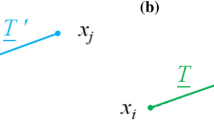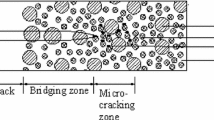Abstract
The process of propagation, kinking of microcracks in concrete and the interaction among cracks as well as the induced failure were analyzed using the model that describes the wing type crack from the point of view of micromechanics. The pseudo-force method is applied to calculate the compressive strength factor of kinky propagated crack taking into account the effect of interaction among cracks. On the assumption that the micro fracture toughness of concrete does not vary with stain rate, the static and dynamic strength of concrete under different confinements can be calculated. The comparison of calculation result with experimental data indicates that a good agreement is achieved which implies that the model can be used to explain the rate-dependent properties of concrete in multi-axial stress state.
Similar content being viewed by others
References
Gran J K, Florence A L, Colton J D. Dynamic triaxial test of high-strength concrete. Journal of Engineering Mechanics, 1989, 115(5): 891–904
Song Yupu, Lü Peiyin, Hou Jingpeng. Concrete splitting tensile strength and failure criterion for different loading rate and lateral stress. Shuili Xuebao, 2002, 33(3): 1–5 (in Chinese)
Yan Dongming, Lin Gao, Liu Junyu, et al. Dynamic biaxial compressive strength and fracture pattern of concrete with constant confining pressure. Shuili Xuebao, 37(2): 200–204 (in Chinese)
Guo Zhenghai. Strength and Deformation of Concrete: Test Basis and Constitutive Relation. Beijing: Tsinghua University Press, 1997 (in Chinese)
Park H, Kim J Y. Plasticity model using multiple failure criteria for concrete in compression. International Journal of Solids & Structures. 2005, 42: 2303–2322
Richart F E, Brandtzaeg A, Brown R L. A study of the failure of concrete under combined compressive stresses. Engineering Experiment Bulletin No. 185, Univ. of Illinois, Urbana, 1928
Imran I, Pantazopoulou S J. Plasticity model for concrete under triaxial compression. Journal of Engineering Mechanics, ASCE, 2001, 127(3): 281–290
Yu Maoqing. Concrete Strength Theory and Application. Beijing: Higher Education Press, 2002 (in Chinese)
Horri H, Nemat Nasser S. Compression induced microcrack growth in brittle solids: axial splitting and shear failure. Journal of Geophysics Research, 1985, 90: 3105–3125
Ashby M F, Hallam S D. The failure of brittle solids containing small cracks under compressive states. Acta Metallica, 1986, 34: 497–510
Deng H, Nemat Nasser S. Microcrack interaction and shear fault failure. International Journal of Damage Mechanics, 1994, (3): 3–37
Zheng D, Li Q B, Wang L B, A microscopic approach to rate effect on compressive strength of concrete. Engineering Fracture Mechanics, 2005, 72(15): 2316–2327
Author information
Authors and Affiliations
Corresponding author
Additional information
__________
Translated from Shuili Xuebao, 2007, 38(5): 538–545 [译自: 水利学报]
Rights and permissions
About this article
Cite this article
Zheng, D., Li, Q. Micromechanics model for static and dynamic strength of concrete under confinement. Front. Archit. Civ. Eng. China 2, 329–335 (2008). https://doi.org/10.1007/s11709-008-0044-4
Published:
Issue Date:
DOI: https://doi.org/10.1007/s11709-008-0044-4




